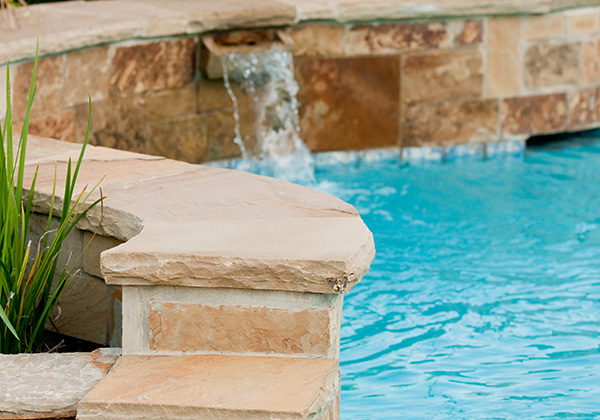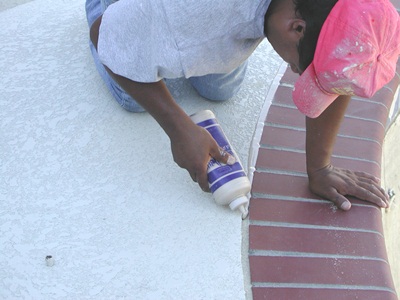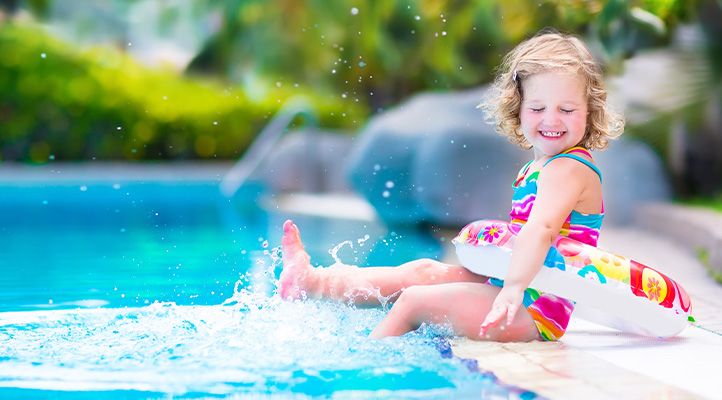What causes brown stains in pools?
Keeping your pool water clean and clear is the key to getting the most out of it. But the undertaking is not as simple as tossing a few pool chemicals and calling off for the day. Balancing the amount is a tough act many times, but it is absolutely essential for a healthier pool experience.
This blog tells you how you can raise or reduce the chlorine levels in your swimming pool. But remember, before adjusting the levels, make sure to test your water first so you can determine the before and after difference.
CHLORINE – WORKHORSE OF YOUR POOL
Chlorine is a pool cleaner that works to break down any bacteria in your pool and thoroughly sanitize the water. It is an ideal way to keep the pool clean and fresh. It is available in different forms, and a pool professional can guide you in determining what would work best for you. However, amounts ranging from 1 to 3 ppm must be maintained in the pool at all times.

TEST AND THEN ADJUST!
You must test the water first, so you know its chemical balance. Just because the water irritates your skin or eyes does not mean high chlorine is to blame. Irritation may also result from low pH levels or a general chemical imbalance. So testing must be your initial approach before you get to raising or lowering chlorine levels to a safe amount.
WHY ADJUST CHLORINE?
A lot of contaminants build up in your pool water. Not just external pollutants, but after each use, the pool does get dirty. Improper doses will not solve the problem of contamination.
So shocking the pool comes to your rescue. However, this demands adding massive amounts of chlorine to destroy all bacteria and organic matter. Next, you must measure the pH values of the water – if it is high, the chlorine will lose its effectiveness; if low, the water still will not be safe to swim. PH levels of about 7.2 to 7.6 do not cause any frustration.
Finally, you can add chlorine through automatic or floating feeders. Regardless of the system you use, maintain chlorine levels between 1.0 and 3.0 parts per million (ppm). Higher levels run the risk of irritations; lower levels do not remove any toxins.
PH levels majorly affect the functioning of chlorine in your pool. So make sure you consistently keep a check on its levels. If you stay updated with testing, any changes can be quickly caught and addressed, as the effect of chlorine neutralizes upon coming in contact with sunlight or any pollutants.
CHLORINE LEVELS TOO LOW? ADJUST AND INCREASE CHLORINE LEVELS!
Raising pool chlorine levels can be much easier as compared to reducing the levels. Reasons that may cause the levels to reduce may include:
- Insufficiently added chlorine
- Bacterial or algae growth
- Cloudy/ murky/ milky water
- Not testing enough
To eliminate these problems, you may simply use chlorine tablets, granules, powder, or liquid shock to increase the amount.
If the water looks murky, shock the pool and raise the levels to around 10 ppm, and wait for it to reduce naturally before swimming. If the water is clear, test and add just a tad bit more to maintain the 3 ppm standard.
Whatever product you use, make sure you read the instructions on using the suitable amount according to your pool needs.
Backwash the water and remove any waste from the bottom to ensure there is no chlorine loss in the pool.
Make sure to use the sticks, tablets, or granules in the later afternoon or evening. This prevents any loss to sunlight, especially if the cyanuric acid concentration is low.
Walk gradually around the pool deck and pour chlorine onto the sides. Run the circulatory pump for about 8 to 10 hours and never put chlorine directly into the skimmer.
Remember, it is always better to start small and go up bit by bit to avoid over chlorinating the pool. Talk to our pool cleaning experts for more information on increasing chlorine amounts in your swimming pool.
CHLORINE LEVELS TOO HIGH? HERE IS HOW TO LOWER CHLORINE LEVELS!
Increasing chlorine levels is pretty easy; bringing it down takes time and is a bit more challenging. Higher chlorine levels wreck your hair, breathing, clothes, eyes, skin, and cause other sensitivities. For this reason, you must test the water beforehand and save yourself from all the associated hassles. But the reasons that may cause the levels to go up include the following:
- Adding too many chlorine tablets
- Not getting enough sunlight
- Not testing enough
One of the most straightforward ways to reducing the level of chlorine in your pool is to leave the pool under direct sunlight without a cover.
Sunlight usually eats away excess chlorine. But you can also drain some of the existing water and add fresh water to balance the levels.
If the levels are not bothersome, swim in the pool to add some contaminants. It is an easy fix without the need for chemicals.
Food grade hydrogen peroxide also does the trick to reduce chlorine levels inexpensively. But this would imbalance the pool’s pH amount as well, so keep that in mind.
Ascorbic acid or vitamin c that boosts your immunity also solves chlorine problems. But you might need a lot of it to do the job, which can get pricey.
Sodium thiosulfate or chlorine neutralizer is another fast and easy method to reduce your swimming pool’s chlorine levels.
NEED PROFESSIONAL ASSISTANCE IN TEXAS? CALL QUALITY POOL SERVICE, INC.
Spend more time enjoying your pool and less on maintaining it. Call for professional assistance if you are anywhere near Texas.
Quality Pool Service, Inc. can help you with all your pool cleaning needs. We are one of the most trusted names in Texas. You can rely on our 40+ years of industry experience to get nothing but the best. Our company is regulated by The Texas Department of Licensing and Regulation, and we are well versed in our job.
To get a free quote, call us at 214-428-6221 or fill in this online form, and well will contact you back with an appropriate solution.
Have you recently noticed any brown stains all over the walls or floor of the pool in your DFW home? Huh! How is that even possible? You are always super vigilant about your pool cleaning and maintenance. You should not be seeing any stains, anywhere in your pool.

Pool owners often determine how clean their pool is just by “feel.” If the water looks clear and does not smell, they think everything is okay and adding some chlorine now and then would keep the pool sparkling. But pool maintenance is more than just that. It can be pretty complicated and requires the monitoring of a couple of factors. If you are not on top of it all, you can end up with unsightly brown stains in an otherwise clean pool.
In this blog, we will tell you all about the sources of brown pool stains as well as tips and tricks on how to remove them.
What causes brown pool stains?
If you want to get rid of those embarrassing stains in your pool, you must first diagnose the stain type. Pool stains can have many sources – it could be an algae buildup or even just plain dirt. But how do you determine which is the one you are dealing with?
One way to identify the source of the stain is to look at the color of the stain.
If the stain on the walls or floor of the pool is greenish-brown, you might be looking at an organic material present in the pool – perhaps an algae buildup or just some leaves, berries, and other organic debris sitting on the floor of the pool. Organic pool stains are not usually hard to get rid of, but over time, they sink down and begin to decay on your pool’s floor.
If the stains are brown-black, and can be found on the sides of the pool as well, it would indicate a metal issue – most often iron or copper buildup. Metal can be introduced into your pool water from corroded copper pipes in your plumbing system or rusted pool equipment.
How to get rid of brown pool stains?
Organic stains
If you have determined the source of your pool stains to be organic, you can easily deal with the problem by heavily chlorinating (shocking) the water and giving your pool a little TLC with a good scrubbing with a long-handled stiff brush. If the stain is truly organic, a regular dose of shock and scrub should take care of the problem. Check the pool to see if the pool is clean. If the stains are still visible after performing shock chlorination, you will have to repeat the process.
Metallic stains
Shocking has little to no effects on metal stains, which means that metals stains are a bit more difficult to get rid of. Metal responds best to chemicals, so you may want to scrub the metallic stains in your pool with a natural ascorbic acid (Vitamin C) based product. A good rule of thumb is to use half a pound of ascorbic acid per 10,000 gallons of water in the pool. If the stain was caused by metal, the scrubbing would remove or at least lighten the stain. If the stains are still visible, add more ascorbic acid. Repeat this process until the stains are gone.
How to prevent stains in the future?
Pool stains can be ugly and tough to get rid of, so once you have removed them, you will want to keep them from coming back. For that, it is crucial that you stay on top of your pool maintenance. With a little effort, you can keep contaminants from making their mark on your pool — literally.
To keep organic stains out of your pool, do what you can to keep the pool clean. This may involve:
- Skimming the pool surface to keep leaves, twigs, and other organic debris from sinking to and settling on the bottom of the pool where they can stain;
- Trimming trees or bushes around the pool; and
- Investing in a better pool cover or an automatic pool cleaner
Preventing metallic stains from returning involves:
- Keeping the pool water balanced (especially the alkalinity, pH, and sanitizer levels) using a good water chemical test kit;
- Maintaining your pool plumbing; and
- Keeping the pH level in the pool steady.
All of this can go a long way to ensure your pool is beautiful and clean for years to come!
We hope that this blog will help you understand brown pool stains a bit more, so you can perform an effective pool stain removal and keep your pool clean and hygienic.
Are you looking for professional pool cleaning in Dallas, Texas?
At Quality Pool Service, Inc., we provide cleaning services to both residential and commercial swimming pool owners in Dallas, Highland Park, Richardson, Garland, Plano, Allen, Frisco, McKinney, Irving, Carrollton, Farmers Branch, Grand Prairie, and all across the Dallas-Fort Worth Metroplex. Whether it is leaf and debris removal, brushing of the pool walls, chemical balance of pool water, equipment inspections, draining, pressure washing or chlorine bathing, our team of pool cleaning experts can do it all to keep your pool sparkling and “stain-free.”
Call Quality Pool Service, Inc., at 214-428-6221 for a free quote today. Also, don’t forget to visit our blog section for more tips and insight into pool ownership in DFW, Texas.
Spend Less Time Taking Care of Your Pool
And Spend More Time Enjoying It!
Call Quality Pool Service, Inc. in Dallas, TX For a Free Quote Today
Spend Less Time Taking Care of Your Pool
And Spend More Time Enjoying It!
Call Quality Pool Service, Inc. in Dallas, TX For a Free Quote Today


10610 Metric Dr #155
Dallas, Texas 75243
214-428-6221
Email Us
Monday-Friday 7am to 4pm
Regulated by The Texas Department of Licensing and Regulation
P.O. Box 12157
Austin, Texas 78711
1-800-803-9202, 512-463-6599
Website: www.tdlr.texas.gov/complaints
